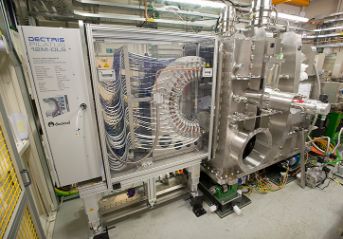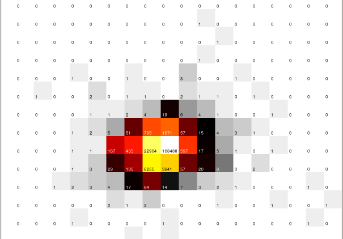Beamline overview
8th June 2020: Access to MX beamlines is currently operating under new guidelines. Please read carefully.
Overview
The long-wavelength macromolecular crystallography beamline I23 is a unique facility for solving the crystallographic phase problem, using the small anomalous signals from sulphur or phosphorus which are present in native protein or RNA/DNA crystals. This is of increased importance for projects where protein labelling to introduce anomalous scatterers is not feasible. In addition, the beamline's wavelength range provides access to the M-edges of elements, with huge anomalous signals offering new opportunities for phasing large molecular complexes.
The unique wavelength range also allows identification and location of lighter atoms of biological relevance such as Cl, K and Ca and assistance with low-resolution model building by locating P or S atom positions.
I23 complements the existing suite of five MX beamlines at Diamond being optimised for operation in the wavelength range from 1.5 to 4 Å. The in-vacuum experimental end station minimizes absorption and scattering effects. A large semi-cylindrical detector allows measurements of a large range of diffraction angles and a multi-axis goniometer is available for crystal alignment and orientation. An X-ray tomography setup will be integrated into the beamline end station to obtain the crystal shape and volume as a basis of an analytical absorption correction.
First successful data has been collected demonstrating the advantages of in-vacuum MX [1,2,3]. An important unique feature of the beamline is the access to absorption edges of physiologically important elements, such as Ca, K and Cl allowing studies of ion binding without substitution with heavier elements [4].
We have already solved a number of difficult structures and we are accepting users' projects. Please get into touch if you have an interesting project which can profit from I23's unique capabilities.
[1] A. Wagner, R. Duman, K. Henderson, V. Mykhaylyk In-vacuum long-wavelength macromolecular crystallography Acta Cryst. D72 (2016) 430-439.
[2] K. Bountra et al. Structural basis for antibacterial peptide self-immunity by the bacterial ABC transporter McjD EMBO J. 36 (2017) 3062-3079.
[3] H. P. Austin et al. Characterization and engineering of a plastic-degrading aromatic polyesterase Proc. Natl. Acad. Sci. USA (2018) 115 (19) E4350-E4357.
[4] P.S. Langan, V.G. Vandavasi, K.L. Weiss, P. V. Afonine, K. El Omari, R. Duman, A. Wagner, L. Coates Anomalous X-ray diffraction studies of ion transport in K+ channels Nat. Commun. 9 (2018) 4540.


 Industrial Liaison Office
Industrial Liaison Office


